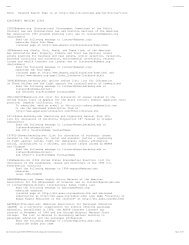BIEDERMANN MOTECH GMBH and Depuy Spine, Inc, Plaintiffs
BIEDERMANN MOTECH GMBH and Depuy Spine, Inc, Plaintiffs
BIEDERMANN MOTECH GMBH and Depuy Spine, Inc, Plaintiffs
You also want an ePaper? Increase the reach of your titles
YUMPU automatically turns print PDFs into web optimized ePapers that Google loves.
Now, <strong>Plaintiffs</strong> <strong>and</strong> Allez have filed cross-motions for claim construction. The other Defendant, Acme, did<br />
not participate in the briefing.<br />
II. TECHNOLOGICAL SUMMARY<br />
The patented pedicle screw of <strong>Plaintiffs</strong> <strong>and</strong> the pedicle screw of Allez are not identical. The structure of the<br />
two kinds of pedicle screws will be described. The Court's description is based on a pretrial review of the<br />
'678 patent <strong>and</strong> the alleged infringing products. This description may be modified as the litigation continues.<br />
The patent at issue uses a short tube with a constricted end, called a "receiver." The receiver has two holes<br />
on opposite sides. The screw is inserted into the receiver before being installed into a vertebra, so that the<br />
receiver can pivot after the screw is installed. The screw has a smooth, rounded head which seats well in the<br />
constricted end of the tube. To attach the rod, a small cylindrical piece of metal called a "compression<br />
member" is placed inside the tube after the screw is installed into a vertebra. One side of the compression<br />
member seats well against the head of the screw. ('678 patent, at fig. 1.) The rod is inserted through the<br />
holes in the receiver. Although claim one does not specify, the patent specification states that the rod is also<br />
inserted through the compression member. The specification states that the rod is threaded, <strong>and</strong> thus, nuts<br />
are used on either side of the receiver to hold the rod in place. The specification states that the nuts can be<br />
applied with sufficient tightness as to flex the receiver against the compression member which presses<br />
against the screw. The patented embodiments were never manufactured, other than a few prototypes which<br />
were destroyed long ago. (Sheehan Decl. para. 21.)<br />
The pedicle screw of Allez uses a short tube with a constricted end, alleged by <strong>Plaintiffs</strong> to be a "receiver."<br />
The other end has two notches on opposite sides. The screw is inserted into the alleged receiver before being<br />
installed into a vertebra, so that the alleged receiver can pivot after the screw is installed. The screw has a<br />
smooth, rounded head which seats well in the constricted end of the tube. To attach the rod, a small piece of<br />
metal, alleged by <strong>Plaintiffs</strong> to be a "compression member," is placed inside the tube after the screw is<br />
installed into a vertebra. One side of the alleged compression member has a smooth ring, which seats well<br />
against the rounded head of the screw. The other side of the alleged compression member has a U-shaped<br />
semi-circular cup. The rod is placed through the two notches of the alleged receiver <strong>and</strong> rests in the Ushaped<br />
semi-circular cup of the alleged compression member. A cap is screwed into the receiver. (The<br />
claim does not recite a "cap." This is a difference between <strong>Plaintiffs</strong>' <strong>and</strong> Allez's technology.) The cap has a<br />
U-shaped semi-circular cup on the bottom, so that when the cap is screwed into the top of the alleged<br />
receiver, the U-shaped semi-circular top embraces the top of the rod. The threaded portion of the cap <strong>and</strong><br />
the U-shaped semi-circular cup can rotate with respect to each other, so that the cap may be screwed tightly<br />
into the alleged receiver while the U-shaped semi-circular cup embraces the top of the rod. The rod pushes<br />
against the alleged "compression member" which in turn presses against the screw, holding the screw in<br />
fixed position <strong>and</strong> preventing the screw from pivoting. While the patented product never made it off the<br />
drawing board, the Allez product has been wildly successful in the marketplace, indicating a fundamental<br />
difference between the two designs. (Order of Jan. 17, 2007, at 16.)<br />
II. LEGAL STANDARD<br />
A. Summary Judgment<br />
The claim construction briefs were brought in an ad hoc format. As claim construction is a matter of law,<br />
the briefs will be treated as briefs for summary judgment. "Claim interpretation is a question of law






